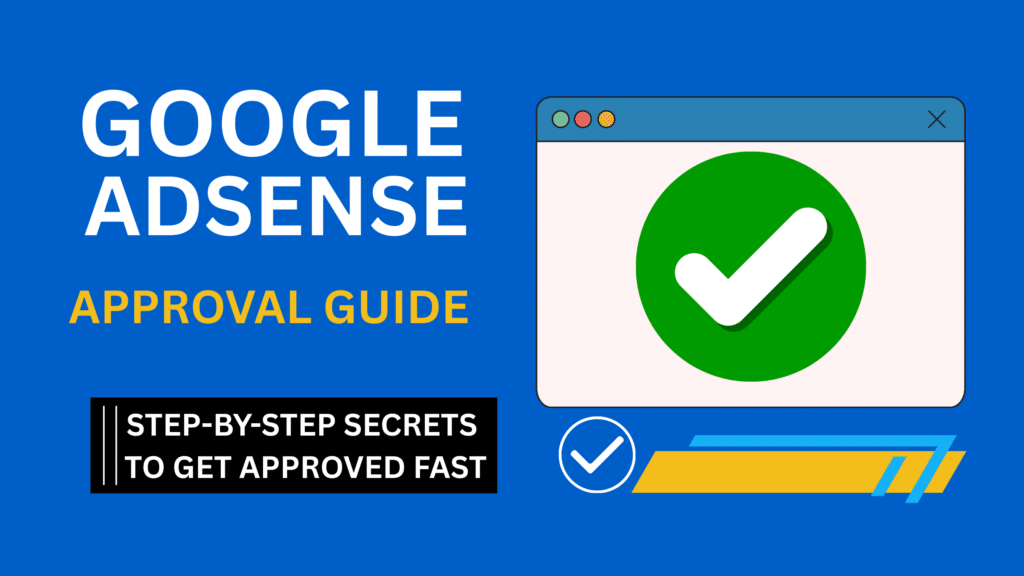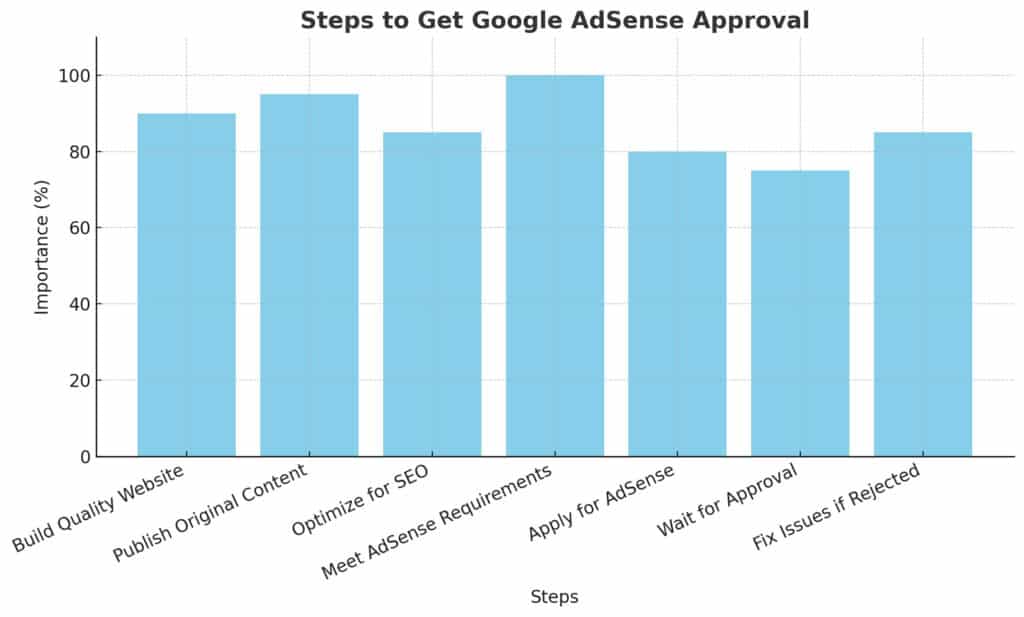Introduction:
Google AdSense is one of the most trusted and widely used platforms for website monetization, helping millions of bloggers and content creators make money online. However, getting Google AdSense approval can seem challenging for beginners, especially with the strict policies and high standards. The good news? With the right step-by-step process, you can meet all the AdSense approval requirements and get approved quickly — even on your first try.

In this Google AdSense approval guide, you’ll discover proven tips, expert secrets, and the right AdSense approval checklist that you need to follow. Whether you run a blog, niche website, or news portal, this guide will walk you through the AdSense approval process in easy steps. We’ll cover everything from creating a professional site and publishing high-quality content to meeting the AdSense eligibility criteria and avoiding common mistakes that lead to rejection.
After completing this guide, you’ll know:
- How to successfully apply for Google AdSense.
- How to Get AdSense Approval Fast Without Unnecessary Delays.
- Follow the right steps to get your site approved on the first try.
If you’re having trouble getting approved or want to make sure your application is flawless, this Google Adsense Approval Tips article will save you time and frustration. Follow each step carefully, and you’ll soon be ready to start showing ads, attracting revenue, and monetizing your website with confidence.
Google AdSense Approval Guide, made easy! Discover step-by-step secrets to get approved fast, avoid common mistakes, and start monetizing your website today.
♦ Understand Google AdSense Eligibility Requirements:
Before you begin the Google AdSense approval process, it’s important to make sure your website and personal information meet all eligibility rules. Ignoring these basics often leads to rejection, even if your site has good content.
1. Minimum Age Requirement
You must be at least 18 years old to qualify for Google AdSense. If you’re under the age of 18, you can still run ads under a parent or guardian’s account until you reach the required age.
2. Country Availability
Google AdSense accepts publishers from most countries, but some regions have restrictions or strict review processes. Always check the official AdSense supported countries list to make sure your location is eligible before applying.
3. Active Google Account
A valid Google account (Gmail) is required to sign up for AdSense. You can use a free Gmail address, but applying with a domain-based email address (e.g., info@yourdomain.com) adds professionalism and builds trust with Google’s review team.
4. Policy and Content Compliance
Your website must fully comply with the AdSense program policies, which means:
- No adult, violent, or copyrighted content.
- No excessive ads, pop-ups, or distracting links.
- No “under construction” pages – your site must be fully functional.
5. Original, high-value content
Google prioritizes websites that provide unique, high-quality, and useful content for visitors. Thin or copied content will almost always be a reason for rejection.
By meeting these AdSense eligibility requirements, you build a strong foundation for a successful application and increase your chances of getting approved on your first try.
♦ Create a Professional Website:
One of the most important aspects of the Google AdSense approval process is a professional-looking website. Even with high-quality content, a poorly designed site can reduce your chances of getting approved. Google evaluates not only your content but also your website design, user experience, and overall structure.
1. Choose a clean, responsive design
Your website should be mobile-friendly and adapt perfectly to all devices – desktops, tablets, and smartphones. A clean layout with readable fonts, proper spacing, and minimal clutter makes a positive impression on both users and Google’s review team.
2. Ensure easy navigation
Visitors should be able to find information quickly and navigate your site without confusion. Use a clean menu bar, well-organized sections, and a visible search function to make browsing smooth and enjoyable.
3. Use a custom domain name
Using a custom domain such as yourwebsite.com gives your site a professional and trustworthy appearance, unlike free subdomains such as yourwebsite.blogspot.com, which can seem less credible to visitors and Google AdSense reviewers. A custom domain builds credibility, increases brand authority, and is preferred during the AdSense approval process.
4. Maintain a consistent brand identity
Keep your design visually consistent by using the same color scheme, logo, and style across all pages. This increases your brand recognition and signals professionalism to both visitors and AdSense reviewers.
5. Optimize for speed
Slow-loading sites frustrate users and hurt your chances of approval. Use tools like Google PageSpeed Insights to optimize images, enable caching, and improve loading times.
A well-designed, professional website not only increases your AdSense eligibility but also keeps visitors engaged, encouraging them to come back.
♦ Publish High-Quality, Original Content:
One of the most important aspects of the Google AdSense approval process is the quality and originality of your website’s content. Even a perfectly designed site can be rejected if it lacks valuable, unique information. Google’s priority is to provide a great user experience, and that starts with high-quality, original content.
1. Write for people, not just search engines
Your articles should be clear, engaging, and understandable. While SEO optimization is important, avoid keyword stuffing or writing just for rankings. Aim to address your audience’s needs by offering practical solutions and actionable insights that deliver real value.
2. Maintain originality
All content must be 100% plagiarism-free. Google has a strict policy against copied or spun articles. Use a plagiarism checker before publishing to ensure originality.
3. Publish in-depth articles
Short, thin content is often rejected. Aim for at least 700-1000+ words per article that covers your topic in detail. Organize your content with clear headings, concise bullet points, and engaging visuals to enhance readability and keep visitors interested.
4. Use relevant images and media
Include original or royalty-free images, infographics, and videos to make your content visually appealing. This increases your engagement and adds more value to your audience.
5. Post consistently
Aim to publish 15-20 well-written articles before applying for AdSense. Consistency indicates that your site is active and being maintained.
High-quality, unique, and user-focused content will not only help you get AdSense approval quickly but will also attract loyal readers and long-term traffic.
♦ Have at Least 15–20 Quality Blog Posts Before Applying:
One of the most overlooked steps in the Google AdSense approval process is the number of articles published on your website. Even if your content is high quality, applying with too few posts can lead to rejection. Google wants to see that your site is active, established, and able to provide consistent value to visitors.
1. Minimum Recommended Posts
Aim for at least 15-20 well-written blog posts before submitting your application. This shows Google that your site is not just a temporary project but a long-term, reliable platform.
2. Maintain quality over quantity
Although the number of posts plays a role, the quality of your content matters far more in securing Google AdSense approval. Each article should be original, informative, and at least 700-1000+ words. Avoid filler content or repetitive topics just to fill the numbers.
3. Cover a range of relevant topics
If your blog is niche-focused, make sure that your posts cover different aspects of the niche. This helps Google understand the purpose of your site and makes it more valuable to readers.
4. Update and improve existing posts
Before applying, proofread and update your articles to correct grammatical errors, add new information, and make sure all links are working properly.
By having 15-20 high-quality blog posts published, you are signaling to Google that your site has enough depth, authority, and activity to qualify for AdSense approval. This step alone can significantly improve your chances of getting approved on the first try.
♦ Create Must-Have Pages Before Applying:
Before you begin the Google AdSense approval process, your website should have some essential pages that establish trust and professionalism. These pages not only improve the user experience but also help Google verify that your site is legitimate and policy-compliant.
1. About Us Page
An About Us page tells visitors (and Google) who you are, what your website is about, and why it exists. Keep it clear, concise, and authentic to build credibility.
2. Contact Us Page
Make it easy for users to contact you by creating a Contact Us page. Include a contact form, email address, or business phone number. Adding a Google Map for location-based businesses can further build trust.
3. Privacy Policy Page
This is required for AdSense approval. A Privacy Policy page informs visitors about how their data is collected, stored, and used on your website, ensuring transparency and compliance. You can create one using an online privacy policy generator, but customize it to suit your site’s needs.
4. Disclaimer / Terms and Conditions Page
A Disclaimer safeguards you legally by stating the boundaries of your content’s accuracy and your responsibility as the publisher. It outlines the terms and conditions of use of your site. These pages help demonstrate professionalism and legal awareness.
Having these required pages indicates to Google that your website is trustworthy, transparent, and adheres to its policies. Missing any of these can reduce your chances of getting approved quickly.
♦ Ensure Your Website Has a Custom Domain:
One of the most effective ways to increase your chances of getting approved for Google AdSense is to use a custom domain name. While free subdomains (like yourwebsite.blogspot.com or yourwebsite.wordpress.com) can host great content, they often come across as less professional to both visitors and Google’s review team.
1. Why Custom Domains Matter
A domain like yourwebsite.com instantly builds credibility and signals that you’re serious about your website. It helps build a strong brand identity and improves trust, which can positively impact the AdSense approval process.
2. Improved Branding and SEO
A short, memorable domain name is easier to promote and is more likely to attract repeat visitors. It can also boost your search engine visibility, helping your site attract more organic visitors and grow its audience.
3. Professional Email Address
Owning a custom domain allows you to create a domain-based email address (e.g., contact@yourwebsite.com), which looks more professional than a standard Gmail account and can add weight to your AdSense application.
4. Easy to buy and set up
You can buy a domain for a small annual fee from trusted registrars like Namecheap, GoDaddy, or Google Domains. Pair it with a reliable hosting provider to give your website a solid foundation.
Switching from a free subdomain to a custom domain is a small investment that can significantly increase your site’s image, authority, and chances of being approved by Google AdSense.
♦ Improve Website Speed & User Experience:
A fast, user-friendly website is not only essential for attracting and retaining visitors, but it also plays a big role in the Google AdSense approval process. Google prioritizes sites that provide a smooth browsing experience, as it directly impacts user satisfaction and engagement.
1. Optimize loading speed
Websites that load slowly often frustrate visitors, causing them to leave quickly and increasing your site’s bounce rate. Leverage tools such as Google PageSpeed Insights or GTMetrix to analyze and optimize your website’s performance. Compress large images, enable browser caching, and reduce unnecessary scripts to speed up loading times.
2. Mobile-friendly design
Half of internet traffic comes from mobile devices, so your site needs to be fully responsive. A mobile-friendly layout ensures that your content displays perfectly on smartphones and tablets, which improves both SEO rankings and your chances of getting AdSense approval.
3. Simple, clean navigation
A good user experience starts with simple navigation. Use a clear menu structure, organized categories, and a visible search bar so visitors can find content quickly without getting frustrated.
4. Avoid distractions
Limit pop-ups, auto-play videos, and additional ads that can annoy users and detract from engagement. A clutter-free design helps visitors stay engaged and concentrate on the content you’re providing.
5. Test and improve regularly
Regularly track your website’s loading speed and user experience, making timely updates to ensure optimal performance.
A website that loads quickly, works flawlessly on all devices, and provides a smooth browsing experience will not only keep users happy but will also increase your chances of getting Google AdSense approval on the first try.
♦ Use a Professional Email Address:
Using a professional email address (e.g., contact@yourwebsite.com) instead of a generic email address like yourname@gmail.com builds credibility with Google AdSense reviewers. It shows that you own a legitimate business or brand and are serious about maintaining your website.
Many hosting providers offer free or low-cost email services linked to your domain. Setting up a professional email makes communication with advertisers, partners, and viewers more credible, which increases your chances of getting approved for AdSense.
♦ Check for Policy Compliance:
Before applying for Google AdSense, thoroughly review your website to see if it follows the Google AdSense program policies. This means avoiding prohibited content such as adult content, copyrighted content without permission, violent or hateful material, and misleading information.
Your site should avoid excessive advertising, spammy links, or any tactics that violate Google’s guidelines. Make sure your content is original, safe for all visitors, and adds real value. Adhering to the policies not only improves your chances of approval but also protects your account from future suspensions or terminations.
♦ Drive Some Organic Traffic Before Applying:
Prior to applying for Google AdSense, work on attracting organic visitors from popular search engines such as Google and Bing. Organic visitors signal to AdSense that your site has real value and is attracting visitors. Focus on SEO techniques like using relevant keywords, optimizing meta titles and descriptions, and creating shareable content.
Promote your articles on social media, participate in niche communities, and build backlinks from reputable sites. A steady stream of traffic not only increases your chances of approval but also your earning potential once the ads go live.
♦ Submit Your AdSense Application:
Once your website fulfills all Google AdSense eligibility criteria and is optimized for a smooth user experience, the next step is to proceed with your application. First, go to the official Google AdSense website and click on the “Get Started” button. You will be asked to sign in with your Google account (specifically the account linked to your website) and provide basic details like your site’s URL, language, and payment country.
It’s important to double-check that your site is policy-compliant, mobile-friendly, and contains high-quality, original content before submitting. This increases your chances of approval and prevents rejections due to avoidable mistakes. Also, make sure that your site has essential pages like a privacy policy, about, and contact, as Google often looks for these when reviewing applications.
After you apply, Google conducts a thorough review of your site to ensure it complies with their program policies. This evaluation period can range from just a few days to several weeks, depending on the number of applications they are processing. During the review period, keep your site active by publishing new content and engaging with your audience. If approved, you will receive an email confirmation and you can start placing AdSense ads to monetize your website and earn from your traffic.
♦ Wait for Approval & Respond Promptly:
After submitting your Google AdSense application, you will need to patiently wait for approval.
During this time, Google’s team will review your site’s compliance, quality, and overall readiness to display ads.
If Google requests additional information or asks you to make changes, respond promptly to avoid delays.
Timely communication and quick coordination can speed up the approval process and increase your chances of being accepted.
♦ Common Reasons for Rejection & How to Fix Them:
Many AdSense applications are rejected due to avoidable issues.
Common reasons include insufficient content, plagiarized or low-quality posts, policy violations, and a very new website or lack of regular traffic.
To fix these issues, make sure your site has at least 15-20 high-quality, original posts that are valuable to readers.
Check and remove any copyrighted or duplicate material.
Review Google’s program policies to ensure your site follows all guidelines, including required pages like a privacy policy, about, and contact.
Also, work to improve the site’s design, speed, and user experience before reapplying.
♦ Final Tips to Keep Your Account in Good Standing:
To keep your Google AdSense account active and in good standing, follow Google’s policies and guidelines consistently.
Avoid clicking on your own ads or promoting others, as this violates AdSense rules and can lead to account suspension.
Consistently create and share valuable, unique content to keep your audience engaged and attract steady traffic.
Monitor your site’s analytics to track performance and quickly address any sudden drops in traffic or revenue.
Ensure your website is responsive, loads fast, and delivers a smooth, enjoyable experience for visitors on all devices.
Finally, stay up-to-date on AdSense policy changes to avoid accidental violations and keep your earnings safe.

♦ Conclusion:
Ultimately, securing Google AdSense approval isn’t just about meeting the basic requirements – it’s about creating a high-quality, credible, and user-friendly website that provides real value to visitors. Start by choosing a professional custom domain, creating essential pages like privacy policy, about, and contact, and ensuring your site has at least 15-20 well-written, original blog posts. Focus on solving your visitors’ problems, make sure your content is easy to read with headlines, bullet points, and visuals, and that your site is mobile-friendly with fast loading speeds.
Before applying, drive some organic traffic from search engines like Google and Bing to show your site’s credibility. Once everything is ready, submit your AdSense application and patiently wait for Google’s review, which can take anywhere from a few days to a few weeks. If your application is rejected, address the identified issues thoroughly before submitting it again.
Once approved, maintain high standards by regularly publishing new, quality content, monitoring your site’s performance, and strictly following AdSense policies. This not only ensures your account remains in good standing but also boosts your long-term revenue potential.
Ultimately, the key to long-term AdSense success is consistency, compliance, and a genuine focus on providing a great experience for your visitors.
♦ FAQs:
What is the ideal age of a website before applying for AdSense?
While there’s no fixed rule, websites older than 3–6 months tend to have higher approval rates, especially in certain countries where minimum age requirements apply.
Do I need an SSL certificate for AdSense approval?
Yes, having HTTPS not only improves trust but is increasingly seen as a standard for meeting AdSense policies.
How important is a privacy policy page for AdSense?
Extremely important — Google requires clear privacy, terms, and contact pages for compliance.
Does AdSense approve websites with AI-generated content?
Yes, if it’s original, valuable, and not spammy — but human editing is strongly recommended.
Should I disable pop-ups before applying?
Yes, intrusive ads or pop-ups harm user experience and may cause rejection.
Is niche selection important for AdSense approval?
Yes, competitive niches with quality, advertiser-friendly content have higher earning potential.
Can I use AdSense with a subdomain?
Yes, but having your own top-level domain increases credibility.
How much content should each page have before applying?
Aim for at least 800–1,200 words per article for better chances.
Should I use Google Analytics before applying?
Yes, it shows site activity and proves you have real, organic visitors.
Will broken links affect my approval?
Yes, too many broken links harm user experience and can cause rejection.
🔔 Stay Updated with Tech Terapias
Join our free newsletter — get AI tools, blogging tips & smart tech updates!
We respect your privacy — no spam ever.
Keywords:
Google AdSense Approval Guide,
Google AdSense approval process,
AdSense step-by-step guide,
Google AdSense approval tips,
How to get AdSense approval,
AdSense approval requirements,
AdSense eligibility,
Google AdSense rules,
AdSense policy guidelines,
How to get Google AdSense approval fast,
Step-by-step process for AdSense approval,
Google AdSense secrets to get approved,
Tips to get AdSense approval on first try,
How to apply for Google AdSense successfully,
Common mistakes to avoid in AdSense approval,
Google AdSense approval checklist,
How to get AdSense approval without rejection,
Google AdSense approval guide for YouTube,
Minimum traffic for AdSense approval,
How to get Google AdSense approval in 1 minute,
Google AdSense approval requirements,
AdSense approval requirements for Blogger,
AdSense approval checker,
How much traffic required for AdSense approval in Blogger,
Google AdSense requirements YouTube,




